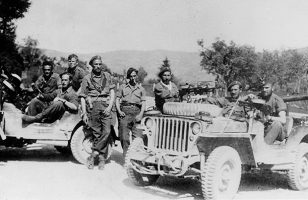The invasion of Sicily in July 1943 was based on two Allied armies landing on the island. The US 7th Army were tasked to land on the south-west at Gela, with the British 8th Army on the south-east at Pachino and Cassibile.
The 8th Army included Brigadier Bob Laycock’s Special Service Brigade, which consisted of Nos 40 and 41 (RM) Commandos, No.3 Commando and Paddy Mayne’s Special Raiding Squadron (SRS).
When David Stirling was captured at the beginning of 1943, 1 Special Air Service (SAS) Regiment was reorganised into two squadrons: George Jellicoe’s Special Boat Squadron (SBS) and Paddy Mayne taking over the SRS.

The invasion
Part of the invasion plan was for Nos 40 and 41 (RM) Commandos to attack coastal batteries at Pachino, while No.3 Commando were to deal with a battery near Cassibile. The SRS’s objective was to capture and destroy the coastal defence battery at Capo Murro di Porco, on the strategically important south-east peninsula.
For their part in the attack the SRS came under the command of General Dempsey’s XIII Corps. General Dempsey had seen Mayne and his men in training, and was impressed by the Ulsterman and his unit. So much so that he gave Mayne two parts to his orders: firstly, the capture and destruction of the battery; and secondly – “Subsequent action at discretion of OC Squadron” – effectively giving Mayne carte blanche to wreak havoc on the enemy held coast.
In the early hours of 10 July, in a heavy swell that had been whipped up by strong winds, the SRS landed unopposed. With speed, and well-rehearsed drills, they disembarked from their landing-craft, crossed the beach and scaled the cliff – a classic commando landing perfectly executed.
Paddy Mayne locates the target
On top, they formed up in three troops of four officers and about seventy men. Paddy Mayne immediately located the target and ordered the mortar section to engage the battery – which they did with pinpoint accuracy.
With flames illuminating the besieged battery, Mayne initiated the ground assault on the target. No.1 Troop attacked from the north, while No.2 Troop made a flanking movement before hitting it from the south. No.3 Troop were dispatched to stop reinforcements from aiding the battery.
Less than an hour after hitting the beach the battery had been captured and destroyed. Concentrated fire and trademark aggression had killed around fifty enemy troops and bagged nearly sixty prisoners – in return the SRS suffered no casualties.
With the job done Mayne contacted HQ and was told his next move was for him to decide. Without hesitation he and his men were off, tearing up the coast like pack hounds.
For the next fifty hours or so Mayne used his discretion, just as General Dempsey had ordered. By the time they were told to re-embark in their craft they had captured and destroyed three batteries and partially destroyed a fourth, taken a large number of prisoners and killed or wounded about two hundred enemy troops – at a cost of one of their own killed and two wounded.
Just as they had done on their stealthy night raids on enemy airfields in the North African desert, Paddy Mayne and his men had excelled at a completely different type of raiding. Mayne’s ability to plan and execute the operation in a different theatre of war didn’t go unnoticed: “a brilliant operation, brilliantly planned and brilliantly carried out,” was General Dempsey’s assessment.
For books by Ian McHarg click here





Well done!